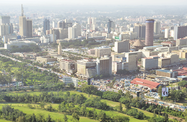In contrast to many other large African markets, Kenya was less affected by sustained low commodity prices during 2016 and continued to post strong growth throughout the year, despite a slight heating of inflation and tighter credit climate.

The Kenyan economy continued to expand well above the global average in 2016, with the IMF projecting year-end growth of 5.98%, up on 5.64% in 2015. The forecast is in line with the 5.7% growth posted in the third quarter, according to data released by the Kenya National Bureau of Statistics (KNBS) in late December.
Looking ahead, the economy is expected to maintain its steady growth trajectory, with the IMF forecasting rises of 6.13% in 2017 and 6.46% the following year.
Ups and downs
Some of this coming growth will be fuelled by production starting at oil fields in the South Lokichar Basin in the northern Turkana County. Full production will come on-line in 2020, providing Kenya with export capacity, but initial output starting in the first quarter of 2017 should help meet domestic demand and reduce fuel import costs.
The revenues from hydrocarbons production will help to offset lower output from some of Kenya’s traditional commodity earners, with a lack of rainfall in the second half of 2016 reducing expectations of strong growth in tea, and to a lesser extent coffee, output.
Year-end targets for tea production will likely be missed after lower-than-average rainfall in the second half of the year saw weaker yields in late-season harvests. The government had set a target of 500m kg of tea output for 2016, but Kenya – the world’s largest tea exporter – is likely to fall well sort of this, with only 308.1m kg picked in the first eight months of the year.
Mixed fiscal messages
While many African economies struggled with a stronger dollar and depreciating currencies over the year, Kenya managed to sidestep much of the volatility. Inflation softened somewhat towards the end of the year, to 6.35% in December, down from 6.68% at the end of November, according to figures issued by the KNBS.
November’s nine-month high was itself below the 7.78% rate posted in January, which had been mainly driven by higher food costs caused by drought conditions late in 2015 and into 2016, and by increases in some tariffs – such as on alcohol and tobacco – that came into effect at the start of the year.
Though inflation began to edge up again late in the summer, the Central Bank of Kenya (CBK) decided at the end of November to keep its key rate unchanged at 10% at its final monetary policy committee meeting for 2016.
The CBK said inflationary pressures were still mild, but noted that domestic and global uncertainties could affect rates in the new year. In particular, it cited the possible impact of the decision to cap bank-lending rates at 4% above the key central bank rate, and the potential for shifts in US monetary policy to have an effect on capital flows.
Financial fault lines
While the economy continued to expand strongly, there was also an increase in non-performing loans (NPLs) held by Kenya’s commercial banks, with the total value topping KSh207bn ($2.01bn) at the end of the third quarter of 2016 – up KSh17bn ($165.8m) on the previous quarter and KSh82.2bn ($801.8m) on the year-end total in 2015.
The swell in NPLs caused the banking sector to become more cautious in 2016: lending growth was down sharply on the previous year, according to CBK data, slowing to 4.6% year-on-year in October. Month-on-month lending had eased from September, when it was 4.8%, a marked fall from the 20.6% expansion from the same month in 2015.
Nonetheless, the central bank reported applications for loans had risen by an annualised 14.8%.
The rise of bad loans prompted most of Kenya’s listed banks to increase their provisions to cover NPLs, a measure that will have eroded shareholder dividends in 2016. Between them, Kenya’s 11 listed commercial banks had raised their loan-loss provisions to KSh25bn ($243.9m) as of late September, from KSh11bn ($107.3m) in the same month in 2015.
The resulting deceleration of credit growth and loss of liquidity could restrict private sector development in the new year, potentially putting projected GDP expansion under pressure.


